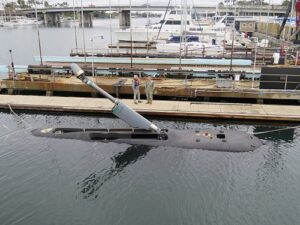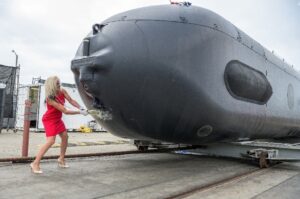Navy officials recently confirmed the Orca Extra Large Unmanned Undersea Vehicle (XLUUV) program has been “re-phased” and pushed back in the schedule, with the fiscal year (FY) 2025 budget request documents illustrating the latest timeline.
“While some of the larger platforms like XLUUV and LUSV are being rephased – overall we continue to see unmanned as the future of so many important naval capabilities and we are making those investments in this budget,” Under Secretary of the Navy Erik Raven told reporters on March 8 ahead of the FY ‘25 budget request release earlier this month.

The Navy’s research and development accounts are due to significantly lower spending on XLUUV from $104 million in FY 2024 to $21 million in 2025.
Budget documents noted this is $5 million less than previously planned due to “program adjustment,” a nod to the re-phasing.
Through the rest of the five year Future Years Defense Program (FYDP), the Navy plans to spend $41 million in FY ‘26 then about $13 million annually from FY 2027 to 2029.
The Orca XLUUV program was established to address a Joint Emergent Operational Need (JEON) in the Indo-Pacific and was originally planned to rapidly deliver five vehicles to the fleet.
Boeing [BA] is the prime contractor for Orca, working with shipbuilder HII [HII]. Boeing delivered the first engineering development model (EDM) vehicle, dubbed the XLEO, in December (Defense Daily, Dec. 20, 2023).
While Phase 2 of the program down-selected to Boeing in FY 2019 for fabrication and testing, the actual testing and delivery of the vehicles was delayed to FY 2023 to 2025 “due to contractor challenges and supplier issues,” the budget documents said.
“The Navy is working with Boeing to mitigate schedule delays and execute risk reduction testing, which initiated in FY23 through the addition of a designated test and training asset,” the documents added, referring to XLE0.
A 2022 Government Accountability Office report said the XLUUV is three years behind schedule with major cost overruns due to poor business planning. One of the main problems was the Navy had no requirements for Boeing to demonstrate its readiness to build the Orca to the Navy’s actual configuration, requiring significant changes from the company’s Echo Voyager base design (Defense Daily, Sept. 29, 2022).
As recently as January, Capt. Scot Searles, program manager of Unmanned Maritime Systems, said all five vehicles were still on track for delivery by the end of 2024 (Defense Daily, Jan. 26).

However, the delivery schedule for the five Orcas has now been pushed back a few fiscal year quarters, into FY 2025.
While the FY ‘24 budget planned for all five vehicles to be delivered between quarters two and four of FY ‘24, the latest schedule is XLUUVs 1 and 2 will be delivered in the fourth quarter of FY ‘24, Vehicle 3 delivered in the first quarter of FY ‘25, and Vehicles 4 and 5 delivered in the second quarter of FY ‘25.
In FY ‘24, the Navy said it plans to continue a series of risk reduction testing events with XLE0 that are required to support Vehicles 1 to 5, complete phase 2 fabrication of Vehicles 1 to 3, conduct contractor testing to verify system requirements on Vehicles 1 and 2, and prepare systems for government testing and begin minimal government testing and fleet training.
It will also continue additional XLUUV technology capabilities risk reduction by leveraging the competitive industrial base, continue infrastructure development to support basing XLUUV in the continental U.S., and continue subsystem testing for payload integration.
Then, in FY ‘25, the Navy plans to complete phase 2 fabrication of Vehicles 4 and 5, conduct contractor testing to verify system requirements on Vehicle 3-5, and prepare systems for government testing. It also plans to complete subsystem testing for payload integration to support fleet transition.
Another change to the schedule is having the risk reduction testing on XLEO continuing through the end of FY ‘24 instead of the middle of FY ‘24. Employment of the five vehicles is still scheduled to start in the third quarter of FY ‘25.
Given these delays, the budget documents said the Navy would only award additional Orca systems no earlier than fiscal year 2026, “gradually ramping up quantities in future fiscal years, depending on the progress from the first five systems.”